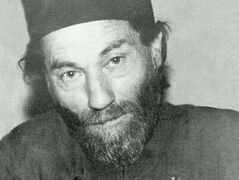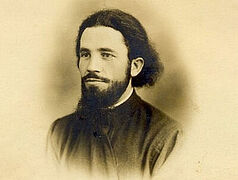Fr. Ilarion Felea (1903–1961) was among the sixteen twentieth-century saints canonized by the Holy Synod of the Romanian Orthodox Church at its July session. He was canonized as a hieromartyr, to be commemorated on September 18 (new style).
***
Fr. Ilarion was a professor in the Department of Dogmatics and Apologetics at the Theological Academy of Cluj (1937–1938), and professor and rector of the Theological Academy of Arad (1938–1948). He was arrested thrice: in 1945, 1949, and 1958. He was imprisoned from January 6, 1949 to January 6, 1950, and from September 1958 to September 18, 1961. He served his sentence in prisons and correctional colonies in Caracal, Arad, Bucharest, Gherla, and Aiud, where he died in the same year as other priest-professors who were imprisoned with him: Floru Mureşan and Liviu Galaction Munteanu.1 It’s unknown where they were buried.
He wrote many theological works, the main being the four-volume To Tabor, which Fr. Justin (Pârvu) called “the best work of Romanian Orthodoxy to date. Fr. Ilarion Felea is a true liturgical genius of Orthodox theology, of the Orthodox Church… The work To Tabor is second only to that treasure of Orthodoxy known as the Philokalia, being a perfect interpretation of it.”
Fr. Ilarion was born on March 21, 1903, in the village of Valea Bradului in Hunedoara County, where his father was the priest. He went to elementary school there in 1910–1914, to the Avram Iancu Lyceum in the city of Brad in 1914–1920, and to the Moise Nicoară Lyceum in the city of Arad in 1920–1922. In 1922–1926, he studied at St. Andrew’s Theological Academy in Sibiu. In the 1926–1927 school year, he worked as a teacher’s assistant at the Avram Iancu Lyceum. On July 29, 1927, he was ordained to the priesthood and on August 6, he was appointed the parish priest in his home village of Valea Bradului. In 1927–1929, he studied in the Department of Philology and Philosophy of the University of Cluj. On August 30, 1930, he was transferred to the Cathedral of the Descent of the Holy Spirit in the city of Arad, Shega District.
 Avram Iancu Lyceum in Brad. Photo: apuseni.info
Avram Iancu Lyceum in Brad. Photo: apuseni.info
At the Arad parish, the young priest inherited a new church, a simple rectory, the House of Culture—a former Orthodox school, and all this needed to be restored and expanded. He set to work with the courage of a fighter, ready to sacrifice himself for the people and the Church. He served in the altar reverently, with the zeal of a missionary. He was a pastor by calling and soon won the hearts of the faithful. At the same time, Fr. Ilarion continued his theological studies and literary works, with which he debuted in the Theological Journal of the city of Sibiu in 1924.
On December 20, 1932, he defended his thesis, “Salvation in the Orthodox, Catholic, Protestant, and Sectarian Understanding,” at the Theological Faculty of the University of Bucharest, and on October 30, 1939, after defending his dissertation, “Repentance: A Study of Theological and Psychological Documents,” which was later published as a separate volume, he was awarded the degree of Doctor of Theology.
Fr. Ilarion contributed to a number of journals and newspapers at the same time. In Sibiu: Theological Journal, Romanian Telegraph, Rural Light, Army of the Lord; in Arad: Church and School, National Defense, Arad, The Border; in Cluj: Rebirth; in Sibiu and Cluj: Illustrated Life; in Brad: Zarandul.2 At the same time, he published the following theological and popular science books: Conversion to Christianity (Sibiu, 1935), Critique of the Baptist Heresy (Sibiu, 1937), God and the Soul in Contemporary Romanian Poetry (Cluj, 1937), Drunkenness from Religious, Scientific and Social Points of View (Arad, 1931), Selected Icons in the Life of Orthodoxy (Arad, 1935), and The Way of the Cross (Arad, 1937).
In the 1937–1938 school year, he worked as a substitute professor at the Cluj Theological Academy. From January 1, 1939, to September 30, 1942, and from July 1, 1952 to September 25, 1958, he served as a priest in the center of Arad, where he was arrested. From October 1, 1938 until 1948, he worked as a full-time teacher of dogmatics and apologetics in Arad. He masterfully taught the students dogmatics, ethics, asceticism, mysticism, and practical homiletics. He continued to contribute to the Theological Journal until 1943, with the journal Spirit and Truth, and with the official publications of the Banat Metropolis and other newspapers and journals in Arad. He would give religious and educational lectures and publish them.
During this period, several of his studies were published, such as, “Theology and Priesthood” (Yearbook of the Arad Theological Academy, 1938–1939), “Paisius and Paisianism” (Cluj, 1940), “Christian Orthodox Catechism” (Arad, 1945), “The Holy Mysteries” (Sibiu, 1946), and “Salvation” (Arad, 1947). He edited the diocesan calendar (liturgical instructions) for 1948, 1952, and 1956 and published an anthology for priests and chanters. He also wrote the cycle “What is Christianity?” which included sermons, lectures, and religious reflections, from which he compiled and published the books The Spirit of Truth (Arad, 1942, awarded a prize by the Romanian Academy) and The Religion of Love (Arad, 1946).
On March 3, 1945, he was arrested together with several cultural figures and clerics and was held in the Caracal correctional labor camp until July of that year.3 He was arrested for the second time on January 6, 1949, having just finished blessing some homes. He was thrown into a dirty and cramped cellar, where they interrogated him. Then he was transferred to the Timișoara penitentiary, and on October 28, 1949, he was tried and sentenced to one year imprisonment for “failure to denounce.” He served his time in Aiud and was released on January 5, 1950.
 The Hieromartyr Ilarion Felea Arad Faculty of Theology. Photo: preotulmartirilarionfelea.wordpress.com After his release, he worked in the Arad Diocese library, and on July 1, 1952, he was reinstated as a priest at the cathedral in the center of Arad. But on September 25, 1958, he was arrested again, taken to the Ministry of Internal Affairs in Bucharest, subjected to brutal interrogations, then transported to Cluj, tried in secret, and on March 14, 1959, the Cluj Military Tribunal sentenced him together with six other Arad priests to twenty years of forced labor and eight years of civil degradation for “conspiracy against social order” and twenty years of hard imprisonment for “intense activity against the working class and the revolutionary movement.”
The Hieromartyr Ilarion Felea Arad Faculty of Theology. Photo: preotulmartirilarionfelea.wordpress.com After his release, he worked in the Arad Diocese library, and on July 1, 1952, he was reinstated as a priest at the cathedral in the center of Arad. But on September 25, 1958, he was arrested again, taken to the Ministry of Internal Affairs in Bucharest, subjected to brutal interrogations, then transported to Cluj, tried in secret, and on March 14, 1959, the Cluj Military Tribunal sentenced him together with six other Arad priests to twenty years of forced labor and eight years of civil degradation for “conspiracy against social order” and twenty years of hard imprisonment for “intense activity against the working class and the revolutionary movement.”
He served his sentence in the Gherla and Aiud prisons, where he died on September 18, 1961. He was buried without a cross in an unmarked grave. The priest and professor Ilarion Felea was crowned with the halo of martyrdom.






